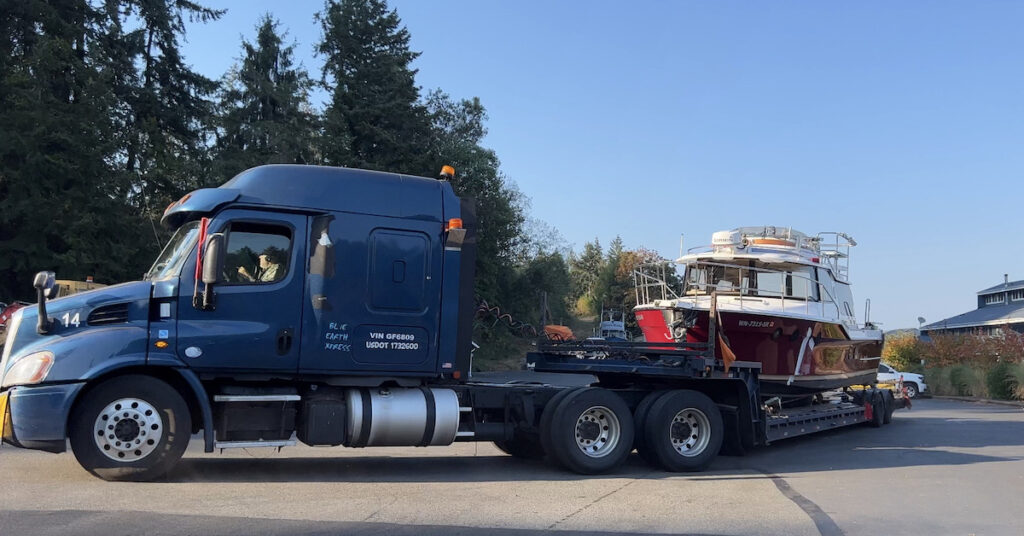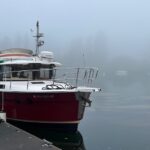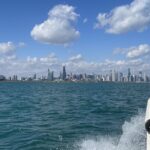We make the move — in less than four days!
If you read all of part one about this boat move, you might remember that we were planning to move the boat on October 3 or 4. Well, the best laid plans…
Plans Change
The first wrench got thrown into the works not long after I finished the post. The shipping company, based in Florida, took a mild hit from Hurricane Ian and then had a delay picking up and delivering the boat before mine. Jess emailed to say that they might be a week late — in other word, come get the boat on October 10. Allowing for a week to deliver it seriously shortened my trip. It also affected our plans; my friend Janet was flying out on October 9 and I couldn’t be in Chicago to pick her up if I had to get the boat on the trailer in Olympia on October 10.
I put up a mild fuss and Jess said she’d see what they could do. They might be able to get the truck to Zittle’s by the afternoon of Friday, October 7. The driver had certain required rest periods — which I knew and understood.
In the meantime, I called Zittle’s and learned that they quit work at 4 PM on Friday and didn’t start up again until Monday morning. The tide was high at around 5 PM on Friday, but because it was a high high tide, they could probably get the boat out as early as 2:30 PM. I updated Jess with this information.
I texted Janet with the news. There was a lot of uncertainty, but I thought that even if they picked the boat up first thing on Monday morning, I should be able to get to Chicago in time to pick her up on Wednesday. (In hindsight, I don’t know what I was thinking. 2000 miles in 2 days?) By some miracle, she was able to change her flight reservations to Wednesday without a huge fee. (Thank you, Southwest Airlines.)
I called Hertz and changed my pickup date from Tuesday to Thursday. If it looked like the truck could get there on Friday, I’d keep that reservation. Otherwise, I’d change it to a Sunday pickup.
I spent the extra days at home cleaning for my house-sitter and doing some gardening. I had a bumper crop of sweet potatoes this year.
Prepping the Boat
I didn’t hear anything from Jess until midday on Thursday, when I was having lunch with the friend who would drive me to pick up the rental car. The driver was on a required rest break but could get to Zittle’s by Friday morning. I reminded her of the tide and recommended that he not get there before noon unless he wanted to sit around at the marina where not much is going on.
I got the rental car, drove home, and loaded it with the stuff I’d been packing all week. I’d decided to go to the boat that evening, spend the night there, and finish prepping it in the morning. So that’s what I did. I made the 4-hour drive with my pups, arriving after 9:30 PM. I loaded one of the dock carts with as much as I could fit into it, went down to the boat, and took most of it inside where the morning dew wouldn’t get it. Then I went to bed.
I was up early and, after coffee, got right to work. I still had to take down the mast and the Bimini top and secure all loose parts. I had to remove and stow all of the fenders and lines I wouldn’t need to move the boat over to the ramp. I had to move the dinghy motor into the boat where I could secure it.
I also had to deflate the dinghy and get it into the aft deck where it could be secured somehow. But I couldn’t do that myself. It was just too damn heavy.
Around 9:30 AM, I went up to the marina office to tell them that the truck would be there that day and confirm the time we could pull out the boat. 2 PM, I was told. I went back to work.
The truck pulled in just after noon. I went up to meet the driver. The tide was way out and the ramp was super steep.

The transport truck at Zittel’s Marina.
The driver came down to the boat with me and told me to undo all of the straps I had on the outside benches holding the covers on. No covers, no straps. He gave me some white tape to use to strap down anything that might get loose, like the Bimini cover bars and one seat that might flip up. I went back to work.
Around 1:30 PM, I was done with all of my prep work except the dinghy. I even had that 52-pound 6 horsepower dingy motor lying down on a piece of cardboard right in the middle of the cabin floor. All my drawers and cabinets were secure and everything was on board that needed to be on board. Everything I’d need for my 2,000 mile drive was already in the rental car — including my pups. The only thing that still needed to be done was deflating and securing the dinghy.
Pulling the Boat Out of the Water
I talked to the guys who would be moving the boat from the water onto the trailer. They’d already talked to the driver and had him reposition his truck. They figured the tide would be high enough at 2:10. I walked down to the boat ramp and took a look. It sure looked shallow to me. I’d have to get the boat to the ramp and turn it around so it was backed in. That would put my prop and rudder right over the concrete. I decided I’d take my time about it.
I went back down to the boat and climbed aboard. I sat up in the command bridge for a while, just looking at the other boats and thinking about the trip that was ahead of me. At about 2:10, I started the engine and transferred the controls on the command bridge. Then I went down and cast off the lines for the last time at Zittel’s Marina.
As usual, the conditions were perfect at the marina. Hardly any wind, no current. The tide was coming in quickly but it didn’t affect the boat. One of the workers was waiting for me with a boat hook at the dock next to the ramp. We decided to park with the starboard side facing in at the end of the dock. We’d get the dinghy off and then we’d use ropes to move the boat around. Plan set, that’s what we did.
The other guy backed the crazy lift trailer contraption down the boat ramp. The first guy pulled the boat back onto it.

One of the guys pulls my boat back toward the lift.
There was some trouble with one of the straps but they sorted it out. Soon the boat was in the right position and the other guy was reeling up the straps. The boat came up out of the water and the operator backed it up the ramp.

The lift operator tightened the straps to lift the boat.

Once the boat’s weight was on the straps, the lift operator backed it all out of the water.
They wheeled the boat over to an area where a power washer was set up. I had asked them to wash the bottom of the boat — even though it had been washed and painted in April and growth had been scraped off in August. The whole bottom was slimy and there was new sea growth on the stern. They cleaned it up pretty good for me — and for the invasive fish inspectors the driver would meet along the way.
Loading the Boat on the Trailer
From the washing area, the lift operator moved the boat back into the wide, open parking lot and turned his rig around. Then he moved toward the back of the truck’s big trailer. The lift’s wheels were far enough apart to straddle the trailer. Because the boat had been backed onto the lift, it was forward as it was lifted onto the trailer.

The lift straddled the trailer to position the boat on top of it.
There was some positional adjustments to try to center the boat on the trailer and made sure it was far enough forward. When the driver was satisfied, the lift operator lowered the boat down onto the trailer and some supports the driver had put into place. Slowly, the lift operator loosened the straps until they had slack. The trailer was holding the weight of the boat. The other marina guy detached the straps and pulled them out from under the boat. The lift backed away.

Once the boat was on the trailer, the driver wasted no time getting it secured.
While the truck driver dealt with securing the boat to the trailer, one of the marina guys and I went back for the dinghy. He deflated it and the two of us moved it over to the boat. Someone brought over a ladder and he climbed up. While he pulled up, I pushed up and we eventually got the dingy back onto the boat, on the aft deck. I used ratchet straps to tie it down to the deck in two places, face down. It wasn’t perfect, but it would have to do.
I also stowed the fenders and lines and locked up the boat. When the driver finished, it was ready to go.
The Long, Long, Long, Long Drive
The driver told me that it was too late to start the drive — it was about 4 PM when we finished — because he couldn’t drive at night. He said he’d spend the night at the marina and start in the morning. He expected to get to Chicago on Wednesday afternoon. I reminded him that if he arrived after 2 PM, the folks at the marina there wouldn’t unload until the next day. It might be better to shoot for Wednesday morning, if possible.
I had the rental car and could have started the drive. I had no place to stay in Olympia and would have to get a hotel room on the road. But I lived kind of on the way and I figured I’d go home and spend the night in my own bed instead of plunking down $100 for a hotel room along the way. So I went home, leaving the car packed, and had a pretty good night’s sleep — on the sofa. My house-sitter had already taken over the bedroom.
But not before I checked the tracker I’d put on the boat. It wasn’t anything special — just a jury-rigged app on a spare cell phone hooked up to a DC phone charger. It told me that the driver had spent the night at a truck stop in Ellensburg, a good three-hour drive from Olympia. Hmm. I’d have to leave early in the morning to keep up with him.
I woke up as early as usual, had coffee, and fed my pups. I checked the tracker. It was barely daylight and the driver was already on the road, heading south on I-84 toward Yakima. Hmmm. It was time to go. I said goodbye to my house-sitter — who was just waking up — and headed out.
And thus I began a long drive on I-90, traveling through Washington, Idaho, Montana, Wyoming, South Dakota, Minnesota, Wisconsin, and finally Illinois. I hope to cover that in another blog post, probably on my personal blog, one day soon.
I did the speed limit — 80 in most states — and covered a lot of ground quickly with very few stops. I kept pretty much up with the driver — although on a different freeway to the north since he was on I-80 — until the tracker went dead somewhere around Cheyenne. That was near the end of the second day (Sunday). On the third day (Monday), I got a text from the driver saying he’d be at the marina by noon on Tuesday.
Hmmm. Was he trying to race me? It was frustrating not knowing where he was. I texted him that I’d be there and then stretched out the day’s drive to 750 miles to make sure that was possible.
I started the last 200+ mile drive from Wisconsin Dells, WI at about 6 AM on Tuesday. It was still dark. I hate driving in the dark, but I had to be there to get the boat launched.
I drove into Crowley’s Yacht Yard parking lot at 10 AM. My boat was there. The driver had arrived less than 20 minutes before me.

The boat on the trailer on its arrival at Crowley’s. Yes, it is listing to port.
Getting the Boat Back in the Water
I spoke to John in the office at Crowley’s and told him where we were waiting. After a while, a guy drove up in a forklift and told the truck driver that he needed to be in the yard on the other side of the road. He moved the truck and I followed in the car, parking by the office and then walking the rest of the way. I didn’t want the rental car to be in the way.
After directing him to park in an exact spot, he got busy removing the rest of the tie-down straps. (He’d already started while we were waiting for forklift man.) I spoke to a few of the guys who worked there — once they’d been told that I was the owner of the boat — and after a while a Travelift drove over on its spindly legs, surrounding the trailer over the boat.

A Travelift positions over the boat on the trailer.
The guys working the lift ran straps under the boat and connected them to the other side of the lift and they lifted the boat slowly off the trailer. Then they began backing the boat off the trailer and away toward a special slip where they put boats in the water. I watched the whole process, taking photos and shooting video footage that I hope to put together soon.

The Travelift driver moved the boat back toward the launching slip.

Traffic jam at the yacht yard; my boat had to park in an alcove to let another boat pulled out of the water pass.
In the meantime, the area all around us was hopping with activity. It was mid-October in the Chicago area and most marinas close for the winter. All boats had to be removed from their slips or moorage. So there was a constant stream of mostly sailboats coming to the dock to be pulled out of the water. Crowley’s has two Travelifts and both were in constant motion. In fact, the operator on my boat’s lift had to park for a few moments in an alcove to let the other lift pluck at sailboat out of the water and pass by.

They lined up the sailboats and used a crane to unstep their masts, one after another.
The other thing they were doing at the marina was unstepping masts. That’s the term for removing a sailboat’s mast so the boat can be stored indoors — Crowley’s had a huge outdoor yard and indoor storage facility — or so it can continue traveling down the Great Loop route, which has many low bridges for the first 30 or so miles. They were very busy unstepping masts with a tall crane and crew of men to handle the rigging of these boats. They were lined up and while we were there, they did one sailboat after another.
Finally, they drove the Travelift into position on the runners over the special slip and began lowering the boat into the water. In only a few minutes, Do It Now was tasting fresh water for the first time.

The Travelift operator positioned my boat over the special slip designed for launching boats.

Do It Now tastes fresh water for the first time.
Once the boat was in the water, the crew scrambled to find my fenders and dock lines. I directed them from a spot alongside the boat. They put out fenders and lines and got the boat secured in the slip.

The crew attached lines alongside the boat to tie it up to the slip.
Then they disconnected the straps on one side and the operator pulled them out from under the boat. The boat was floating in the Calumet River.
Because the nearby dock space was full, they told me I’d need to park on their other dock on the other side of the road. A worker got on board with me as I started the engine. They cast off the lines and we started moving down the river toward Lake Michigan. The nearby drawbridge had just opened and sailboats — probably bound for Crowley’s — were coming through. The worker with me waved enthusiastically to all of them as if we were boaters heading out for a day on the water. He directed me past the bridge to a dock on the other side and helped me tie up.
And that began my two day stay stay at Crowley’s Yacht Yard. More about that in another post.



I heaved a sigh of relief when Do It Now was successfully in the water.
Thanks for sharing this milestone.